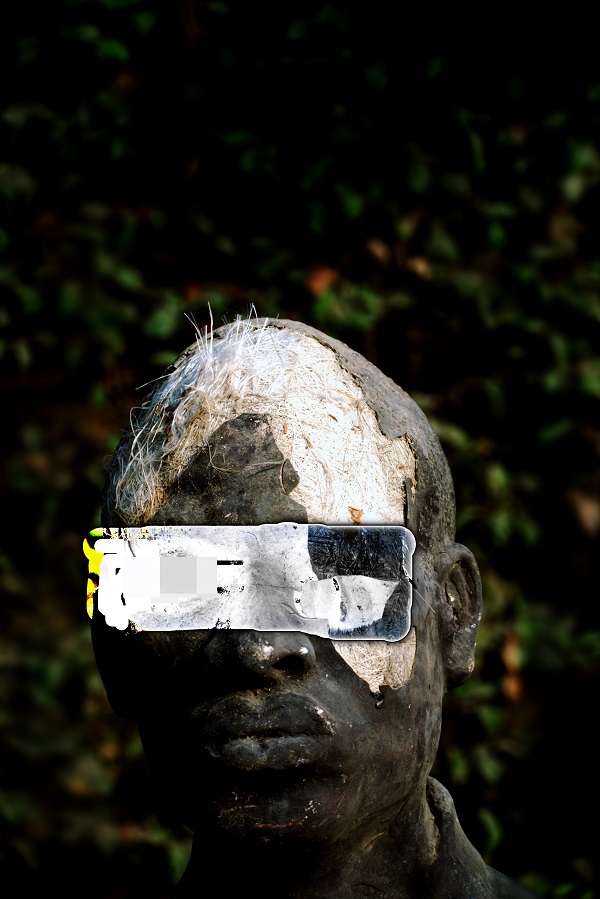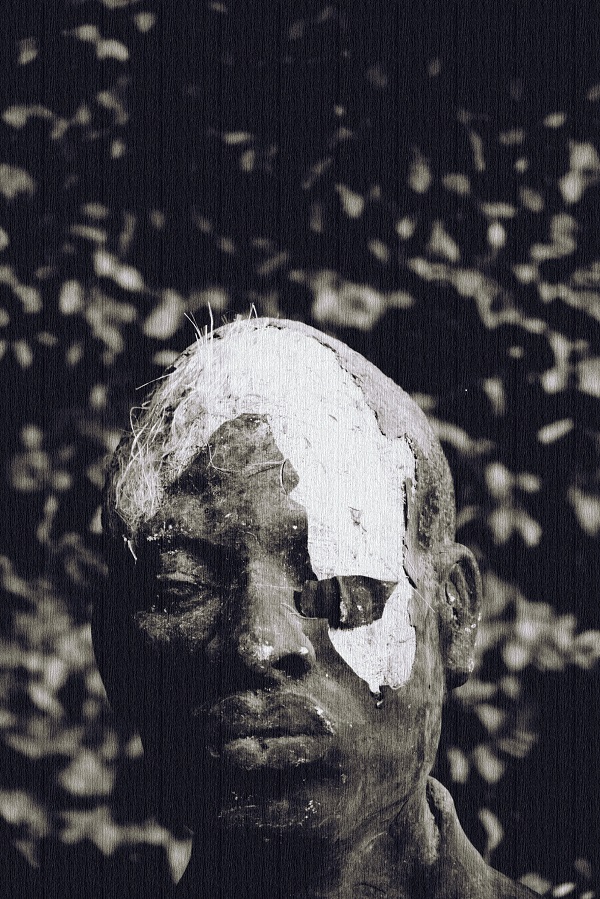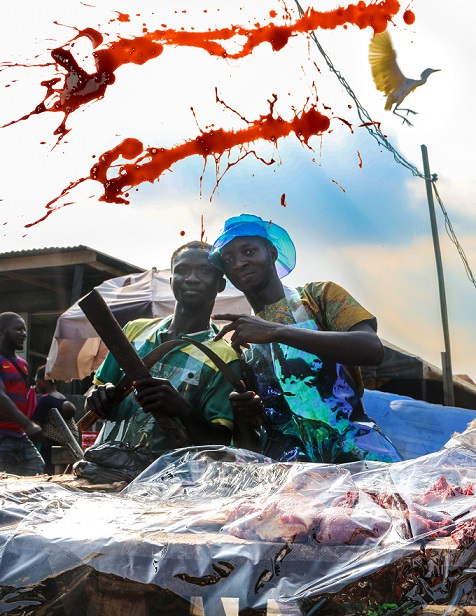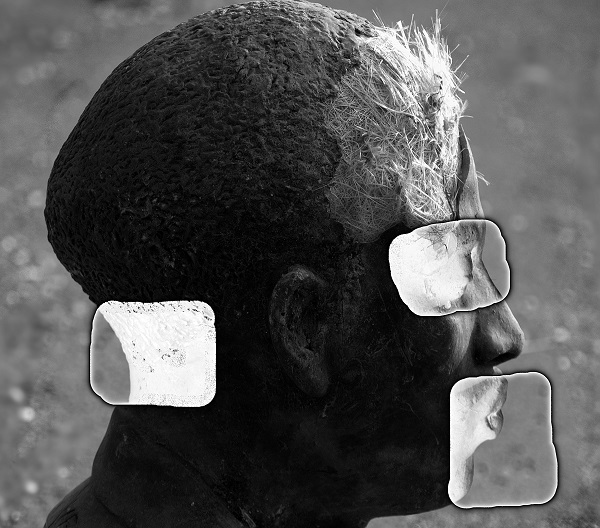
One must consider
the ones who seem irrelevant in the embodiment of society, the ones we
constantly do a disservice to by continually insisting on their transition
towards our systemized conditioning for are we really perceiving with
our endless disposition to intellect the mind that is seemingly infallible.
Now I must ask, who is Fordili?
– Aàdesokan

Fordili, Candid
Sometime in 2016, visual artist from Nigeria, Aàdesokan encountered a nameless sculpture during one of his walks in Yaba, Lagos. What seemed to be an abandoned, derelict work of art presented itself as a revelation to him. It was the head of a man, carved precise. Eyes sullen, and mouth contorted as if impatient. He documented this sculpture in multiple profiles, and the project became “Fordili: A Cenotaphic Allusion to Cognition”. Standing as a representation, an epitaph, of some sort— of the underserved littered around the city of Lagos.
On the 4th through 5th of February, 2021 we were treated to a bundle of artistic eloquence. Aàdesokan packages Fordili in well-rounded punches across mediums to pass a loose message. He exhibits the pictures, doctored to complement his own perspective of the project. A ten-minute montage put together by Rebizm, involving conversations between Fordilli (voiced by Bukunmi Akinniyi) and the artist, providing depth to the unnamed. A Q&A session with Azu Nwagbogu, Founder and Director of African Artists’ Foundation (AAF). A playlist featuring artistes like joeyDECORUM, Deelokz, psiv and Yakeeb, piecing their own part to this complex puzzle. And to round up this bundle, a 48-hour livestream of Obalende bus-stop, allowing us peer into Lagos as it buzzes in wake, and sleep.
In his bio, the artist writes that he creates for revelation, to incite change— ‘any form of it on a supraliminal level’. The project, and it seems Aadesokan’s artistry is infinitely tied to the subconscious. His last exhibition before Fordili, that made him a Foam2020 talent; PVC Meatway is aesthetically fraught, bizarre even. It is a fashion photo-documentary aimed at showing the neglect of hygiene, and non-compliance with health standards within abattoirs. The butchers wear Polyvinyl Chloride (PVC), and bucket hats– conscious of well-being, fashionable in appearance. Almost aspirational in view. He contrasts this with surrealist elements. He employs digital photo-editing to splatter blood on screen. He confronts us with gore, since we have been desensitised to the business of killing livestock. The artist aims to make you ponder when his artworks are assessed. And once away, the thoughts, and consideration of only a moment’s glance never leaves.



PVC Meatway
After his encounter with the sculpture in 2016, Aadesokan went to work. He created Fordili and exhibited bits and pieces around Lagos. Never fully showing the complete experience. The opportunity at FOAM presented him an opening to exhibit Fordili the way he preferred. The artworks were erected in public spaces around Het Stenen Hoofd, Amsterdam and they towered above visitors at a height of 280cm. Aàdesokan, on his Instagram(@Manqbt) shared pictures of attendees gazing at his exhibits. Their poses suggest rumination; in silence— it seems.



Fordili Exhibition, Amsterdam
In one of the images, he replaces Fordili’s sight with a cluster of cyclical shapes. It looks like a flower bloomed. Very similar to how hustlers within the city operate— eyes glazed in search of what can be of use.
“if u sabi u sabi
if man must to die na to live first
shine yur eyes
Fordili no be afoju”
– Aàdesokan (In the Montage)
This is a common denominator for almost everyone here: motorpark denizens, and tie-wearing corporates alike. Every traveller looking to come to Lagos is ladened with varying advice on how to ‘shine their eyes’ for what might lurk in the shadows. Outlandish occurrences in Lagos is no respecter of time, place or people.



Fordili dead
It seems he tells a disarticulate story with this presentation. Fordili dies in one of the pieces and is adorned with what looks like a necklace… bling—if you will. Although it is not stated what kills the man; Aàdesokan, in the montage expresses surprise at his death which suggests it was untimely. This tough entity, that is bordered off to the margins of our reality should ideally be impervious to harm. Yes, he lives a fast life. Yes, it seems he has no code; but to declare that Fordili’s ways caught up with him is to claim a single story of who he is, and what he stands for.



Side profile, Fordili
The existence of the homeless within Nigeria, otherwise labelled the poverty capital of the world comes as a result of numerous socio-political actors in tandem. Aàdesokan touches on this during his conversation with Azu Nwagbogu: revealing he split a certain image of the Man into its color components to widen perspective. He inferred that to view the project through an economic lens is valid, it also stands relevant to see his predicament, and actions as a result of social exposure or a deficiency in the education system— or even, as dominoes falling from far off political games within the country.
Infact, in the Q&A, he uses the color components as his background; and as he rocks back and forth during the interview, some parts of image seep through the opacity of Aàdesokan himself. Although, it is not certain that this was done on purpose: it nevertheless, sprinkles a slant to the narrative built.
This is where, as Nigerian residents, the piece unravels profound realisations. We are all just a few orders of magnitude away from being Fordilis in our own rights. And even if we do not see them, in the existential sense of it, it does not mean their actions do not influence the course of our lives. We hold elections, and a lot of the underprivileged are hired to rig it. We rally for change with #EndSars and some are paid to sprinkle violence within.
What we call an Area Boy—the ones that pick the mantle when everyone else turns up their noses. The ones we do not look at twice because they exist as a backdrop to the bustle within the city. The ones who make us clutch our purses tighter if we see them once night falls. The ones who rest their heads under makeshift shelters, yet we have never cared to find out why.
Not that we do not know in the macro sense of it: as the Nigerian economy strips one of dignity, and the state cares little for its wards. But to delve a bit deeper and learn each story, to take these people, who dot all parts of the city’s experience as individuals; to do the barest minimum, and know a name demands a level of empathy we must have killed to ensure self survival. Aàdesokan challenges that.



Fordili, Candid
The original sculpture at Yaba, left to rot, had been welled by time. A part of the head, peeled to reveal tufts of synthetic material that resembles a coconut shell. The cracks tell of scars on their faces, a decay within the Nigerian dream. It spurs dialogue, as it does question– who is this Fordili, and why is it relevant to me, or my life. It is however apparent that what lies within noticing, and respecting Fordili might be key to breaking off the Nigerian cycle. Empathy that trickles to the grassroots.
But nothing is definite, as this work of art is open to infinite subtitles.
Now you must inquire, what forms the worth of knowledge? You are
nobody until you cease to exist materially, but you see, there are no
absolutes. We need not indulge in what is material and immaterial for
that which unifies all things created is that they exist.
– Aàdesokan
This Cenotaphic Allusion refreshes. With artists lending their talents and worldview to etch more detail in what Fordili might be. The conversation rages on within and around the artwork. As we draw different conclusions, if any, on what it all means. The infinite nature of questions sometimes might be more satisfying than the finality of a response. It is probable Azu Nwagbogu also shares this sentiment. During the Q & A, he suggests to Aadsokan. “I think you should change the name from Fordili: A Cenotaphic Allusion to Cognition; to Fordili: The Cenotaphic Allusion to Cognition.” Aàdesokan chuckled, and nodded.
Watch the Montage, and Q & A here
Oyedele Alokan writes, and edits for theblotted.


Pingback:ART REVIEW: ADEDEJI ENCOUNTERS A STRANGE DREAM WORLD; HIS - the blotted August 20, 2021